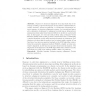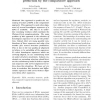138 search results - page 4 / 28 » Learning Models for Aligning Protein Sequences with Predicte... |
CIKM
2009
Springer
14 years 11 days ago
2009
Springer
Background: Although both conservation and correlated mutation (CM) are important information reflecting the different sorts of context in multiple sequence alignment, most of ali...
BMCBI
2008
13 years 5 months ago
2008
Background: Amino acid sequence probability distributions, or profiles, have been used successfully to predict secondary structure and local structure in proteins. Profile models ...
RECOMB
2007
Springer
14 years 6 months ago
2007
Springer
Abstract. Sequence to structure alignment is an important step in homology modeling of protein structures. Incorporation of features like secondary structure, solvent accessibility...
METMBS
2004
13 years 7 months ago
2004
Abstract One approach to predict the secondary structure of RNA is the comparative approach. This approach is used when alignment of several homologous sequences of a RNA is availa...
RECOMB
2009
Springer
14 years 6 months ago
2009
Springer
Abstract. Accurate comparative analysis tools for low-homology proteins remains a difficult challenge in computational biology, especially sequence alignment and consensus folding ...


